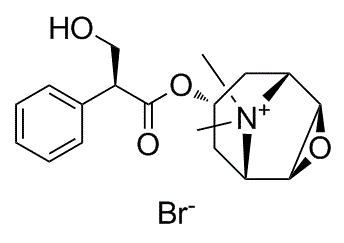All AbMole products are for research use only, cannot be used for human consumption.

Methscopolamine is a muscarinic acetylcholine receptors blocker. It is a muscarinic antagonist structurally similar to the neurotransmitter acetylcholine and acts by blocking the muscarinic acetylcholine receptors and is thus classified as an anticholinergic. It also may work directly on the vomiting center. Methscopolamine bromide must be taken before the onset of motion sickness to be effective. It acts by interfering with the transmission of nerve impulses by acetylcholine in the parasympathetic nervous system (specifically the vomiting center).
| Molecular Weight | 398.29 |
| Formula | C18H24BrNO4 |
| CAS Number | 155-41-9 |
| Solubility (25°C) | DMSO 70 mg/mL Water 60 mg/mL |
| Storage |
Powder -20°C 3 years ; 4°C 2 years In solvent -80°C 6 months ; -20°C 1 month |
[2] No authors listed. Methscopolamine Bromide
| Related AChR/AChE Products |
|---|
| Methoctramine tetrahydrochloride
Methoctramine tetrahydrochloride is a potent and cardioselectivity antagonist of M2 muscarinic receptor. |
| AT 1001
AT 1001 is a high-affinity and selective antagonist of the α3β4 nicotinic acetylcholine receptor (α3β4 nAChR) with Ki of 2.64 nM. |
| Dihydro-β-erythroidine hydrobromide
Dihydro-β-erythroidine hydrobromide is a potent, orally active, and competitive antagonist of neuronal nAChRs. Dihydro-β-erythroidine hydrobromide shows selectivity for α4β4 and α4β2 nAChRs, with IC50s of 0.19 and 0.37 μM, respectively. |
| Spinosad
Spinosad, a mixture of spinosyns A and D known as fermentation products of a soil actinomycete (Saccharopolyspora spinosa), is a biological neurotoxic insecticide with a broader action spectrum. Spinosad targets the nicotinic acetylcholine receptor (nAChRs) of the insect nervous system. |
| TAE-1
TAE-1 is a potent inhibitor of AChE and BuChE. |
All AbMole products are for research use only, cannot be used for human consumption or veterinary use. We do not provide products or services to individuals. Please comply with the intended use and do not use AbMole products for any other purpose.


Products are for research use only. Not for human use. We do not sell to patients.
© Copyright 2010-2024 AbMole BioScience. All Rights Reserved.
